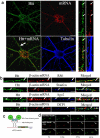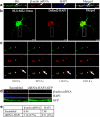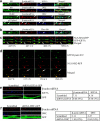Huntingtin mediates dendritic transport of β-actin mRNA in rat neurons
- PMID: 22355657
- PMCID: PMC3216621
- DOI: 10.1038/srep00140
Huntingtin mediates dendritic transport of β-actin mRNA in rat neurons
Abstract
Transport of mRNAs to diverse neuronal locations via RNA granules serves an important function in regulating protein synthesis within restricted sub-cellular domains. We recently detected the Huntington's disease protein huntingtin (Htt) in dendritic RNA granules; however, the functional significance of this localization is not known. Here we report that Htt and the huntingtin-associated protein 1 (HAP1) are co-localized with the microtubule motor proteins, the KIF5A kinesin and dynein, during dendritic transport of β-actin mRNA. Live cell imaging demonstrated that β-actin mRNA is associated with Htt, HAP1, and dynein intermediate chain in cultured neurons. Reduction in the levels of Htt, HAP1, KIF5A, and dynein heavy chain by lentiviral-based shRNAs resulted in a reduction in the transport of β-actin mRNA. These findings support a role for Htt in participating in the mRNA transport machinery that also contains HAP1, KIF5A, and dynein.
Figures







Similar articles
-
Huntingtin coordinates the dynein-mediated dynamic positioning of endosomes and lysosomes.Mol Biol Cell. 2011 Feb 15;22(4):478-92. doi: 10.1091/mbc.E10-03-0233. Epub 2010 Dec 17. Mol Biol Cell. 2011. PMID: 21169558 Free PMC article.
-
A role for huntington disease protein in dendritic RNA granules.J Biol Chem. 2010 Apr 23;285(17):13142-53. doi: 10.1074/jbc.M110.114561. Epub 2010 Feb 25. J Biol Chem. 2010. PMID: 20185826 Free PMC article.
-
A kinesin adapter directly mediates dendritic mRNA localization during neural development in mice.J Biol Chem. 2020 May 8;295(19):6605-6628. doi: 10.1074/jbc.RA118.005616. Epub 2020 Feb 28. J Biol Chem. 2020. PMID: 32111743 Free PMC article.
-
The Huntingtin Transport Complex.Biochemistry. 2025 Feb 18;64(4):760-769. doi: 10.1021/acs.biochem.4c00811. Epub 2025 Feb 5. Biochemistry. 2025. PMID: 39909923 Review.
-
Cataloguing and Selection of mRNAs Localized to Dendrites in Neurons and Regulated by RNA-Binding Proteins in RNA Granules.Biomolecules. 2020 Jan 22;10(2):167. doi: 10.3390/biom10020167. Biomolecules. 2020. PMID: 31978946 Free PMC article. Review.
Cited by
-
Huntingtin is required for normal excitatory synapse development in cortical and striatal circuits.J Neurosci. 2014 Jul 9;34(28):9455-72. doi: 10.1523/JNEUROSCI.4699-13.2014. J Neurosci. 2014. PMID: 25009276 Free PMC article.
-
Is Huntingtin Dispensable in the Adult Brain?J Huntingtons Dis. 2017;6(1):1-17. doi: 10.3233/JHD-170235. J Huntingtons Dis. 2017. PMID: 28339401 Free PMC article. Review.
-
The kinesin KIF1C transports APC-dependent mRNAs to cell protrusions.RNA. 2021 Dec;27(12):1528-1544. doi: 10.1261/rna.078576.120. Epub 2021 Sep 7. RNA. 2021. PMID: 34493599 Free PMC article.
-
Dysregulation of Neuronal Calcium Signaling via Store-Operated Channels in Huntington's Disease.Front Cell Dev Biol. 2020 Dec 23;8:611735. doi: 10.3389/fcell.2020.611735. eCollection 2020. Front Cell Dev Biol. 2020. PMID: 33425919 Free PMC article. Review.
-
Glucocorticoid affects dendritic transport of BDNF-containing vesicles.Sci Rep. 2015 Aug 4;5:12684. doi: 10.1038/srep12684. Sci Rep. 2015. PMID: 26239075 Free PMC article.
References
-
- Gauthier L. R. et al.. Huntingtin controls neurotrophic support and survival of neurons by enhancing BDNF vesicular transport along microtubules. Cell 118, 127–138 (2004). - PubMed
-
- Gunawardena S. et al.. Disruption of axonal transport by loss of huntingtin or expression of pathogenic polyQ proteins in Drosophila. Neuron 40, 25–40 (2003). - PubMed
-
- Bramham C. R. & Wells D. G. Dendritic mRNA: transport, translation and function. Nat Rev Neurosci 8, 776–789 (2007). - PubMed
Publication types
MeSH terms
Substances
Grants and funding
LinkOut - more resources
Full Text Sources
Other Literature Sources
Molecular Biology Databases
Research Materials
Miscellaneous

